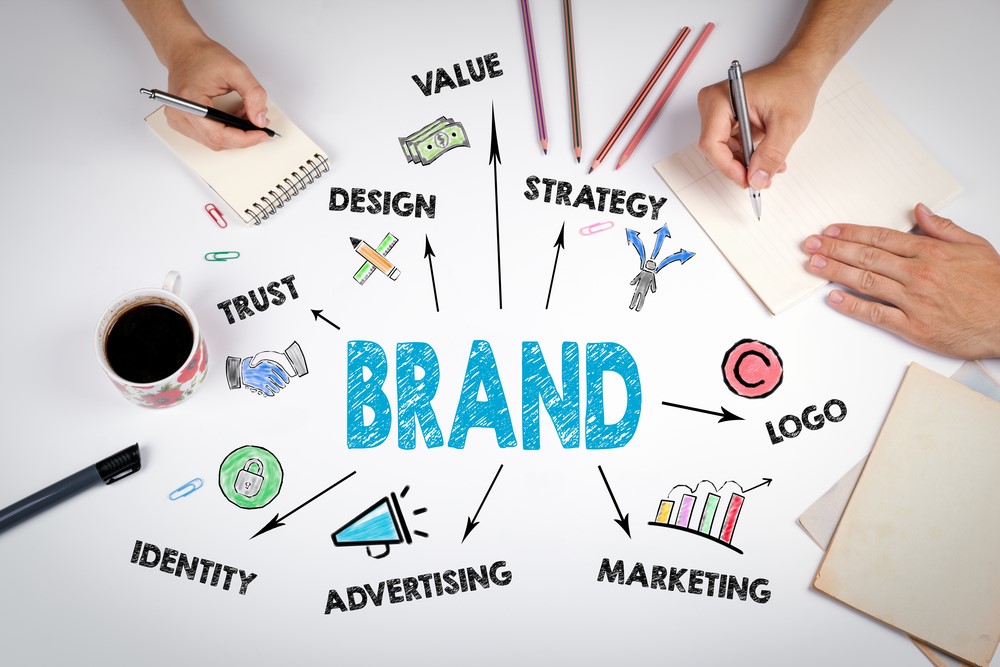One of the newest buzzwords is “brand identity.” While brand identity is not a new notion, many businesses still misunderstand and underuse it.
A logo is only a small part of your brand identification. The company’s logo is just one of many digital assets that you may utilise to build your brand identity. As a result, in addition to your logo, you must pay attention to a variety of other components to build a unique brand identity.
What is Brand Identity
In a nutshell, your brand identity is the sum of your company’s beliefs, how you present your products or services, and, ultimately, what your target audience feels when they interact with your brand. It refers to elements that make it easy for people to recognise your company.
While the terms “brand identity” and “branding” are sometimes used interchangeably, they are two distinct ideas. Simply simply, “branding” refers to the process of actively shaping consumer perceptions of your company.

Why is brand identity so Important
Millions of businesses are looking for new methods to differentiate themselves from their competitors. You’ll need an easily recognisable and memorable brand to accomplish so effectively.
Your brand identity, on the other hand, is about far more than just becoming noticed. It’s a representation of your company’s personality and services. As a result, having a strong brand identity might help you become more appealing to your target audience.
It will not only increase your popularity, but it will also help you establish yourself as a trustworthy industry leader. Your audience, as well as your competition, will regard you as trustworthy and credible if you continue to work on your identification.
It has discovered that more than 80% of consumers must be able to trust a brand before purchasing from it. Furthermore, when a company takes the time to create their brand identity, these first-time consumers are more likely to become repeat customers or even brand evangelists.
It will not only affect your clients, but also your business and employees. Your company’s aim and mission are aided by your brand identity. It also makes your digital marketing plan easier because a well-designed brand identity acts as a roadmap for all of the pieces you’ll need to add. It is becoming much easier to generate advertisements, whether it be a YouTube video or an internet ad.
What defines an Effective Brand Identity?
A strong brand identity is a key element in creating a successful and recognizable brand. Here are some factors that contribute to a strong brand identity:
1.Consistency: A strong brand identity should be consistent across all touchpoints, including the logo, color scheme, typography, messaging, and imagery. This consistency creates a cohesive and recognizable brand.
2. Differentiation: A strong brand identity should differentiate a brand from its competitors. This can be achieved through a unique logo, color scheme, or messaging that sets the brand apart.
3. Authenticity: A strong brand identity should be authentic and aligned with the brand’s values, personality, and mission. Authenticity builds trust and loyalty among customers.
4. Memorable: A strong brand identity should be memorable and easily recognizable. This can be achieved through a unique logo, color scheme, or visual style that sticks in the customer’s mind.
5. Flexibility: A strong brand identity should be flexible enough to adapt to different touchpoints and mediums, while still maintaining its core elements. This flexibility allows the brand to remain relevant and fresh over time.
6. Emotional connection: A strong brand identity should create an emotional connection with the customer. This can be achieved through messaging, imagery, and other elements that resonate with the customer’s values and aspirations.
Overall, a strong brand identity is a reflection of a brand’s values, personality, and mission, and helps to create a consistent and memorable customer experience.
How to Create a strong Brand Identity
Creating a strong brand identity is crucial for any business that wants to differentiate itself from its competitors and build a loyal customer base. Here are some steps to create a strong brand identity:
1. Target Audience
Research, like most things in life, will be an important part of the process. When building a unique brand identity, you should research your target audience and competitors, as well as undertake some introspection and think about your company’s mission, personality, voice, and values.
Advertising that is effective modifies how it markets a product or service to various target populations. To aid you in this phase, learn more about what your target audience is looking for in your particular industry. You may believe that reaching out to everyone is beneficial to your business, but this should never be your goal.
Not only is it beneficial to your business to research your competitors, but it also helps you develop a distinct brand identity (with the emphasis on unique). Focus on the contrasts between you and your competition because the purpose of branding is to help you stand out. This process will also assist you in avoiding branding methods that haven’t worked for your competition.
It’s not enough to know what products and/or services your company provides. You should also have a mission statement that explains your company’s objective, values, and vision. Businesses with strong brand identities are aware of who they are and who their target market is.
2. Value Proposition
A value proposition is a statement that describes the unique value your brand offers to your customers. It is a summary of the benefits that your products or services provide to your customers and how they differ from your competitors. A clear and compelling value proposition can help your brand stand out in a crowded marketplace, attract and retain customers, and drive business growth.
3. Competition
Understanding your competition is critical to building a successful brand identity. Conducting a competitive analysis can help you identify your competitors, their strengths and weaknesses, and their unique value propositions. By analyzing your competition, you can identify opportunities to differentiate your brand and offer unique value to your customers.
4. Mission
Your brand’s mission is a statement that defines the purpose and values of your brand. It outlines the fundamental reason why your brand exists and what it hopes to achieve. A clear and well-defined mission can help your brand attract and retain loyal customers, build a strong reputation, and drive business growth.
 Strong Brand Identity Examples
Strong Brand Identity Examples
There are many strong brand identity examples across different industries, but here are a few:
1. Apple: Apple’s brand identity is sleek, simple, and modern. Their minimalist design, clean typography, and use of white space make their products instantly recognizable.
2. Nike: Nike’s brand identity is all about inspiring and empowering athletes. Their iconic “swoosh” logo, “Just Do It” tagline, and bold typography create a strong and memorable visual identity.
3. Coca-Cola: Coca-Cola’s brand identity is classic and timeless. Their signature red and white color scheme, cursive typography, and iconic glass bottle have remained consistent for over a century.
4. Google: Google’s brand identity is playful, colorful, and innovative. Their use of bright primary colors, simple sans-serif typography, and whimsical animations create a fun and approachable brand.
5. McDonald’s: McDonald’s brand identity is all about convenience, affordability, and consistency. Their golden arches logo, red and yellow color scheme, and use of bold typography have become synonymous with fast food.
6. Airbnb: Airbnb’s brand identity is all about connection and community. Their use of warm colors, hand-drawn illustrations, and playful typography create a welcoming and personal brand.
7. Target: Target’s brand identity is all about affordability, quality, and style. Their use of bright red and white color scheme, bold typography, and clean design create a modern and approachable brand.
Make your own digital design assets
Logo
The logo is a crucial digital asset for establishing a business identity. It will appear on your website as well as in your mailings. Because it will be used so frequently, it will become one of your brand’s most recognisable elements.
As a result, while it should be appealing to the eye, it should also be informative and provide them with additional information about your company. Even if you’re aiming to get a modern appearance and feel, a more vintage logo is preferable. Because your logo should not be changed frequently, it should avoid following the latest trends and instead seek to be timeless.
Brand Color
According to Diane E. Moir’s research, brand colours can increase recognition by more than 80%. Furthermore, the same study discovered that customers make a subconscious judgement on a product in as little as 90 seconds, with colour accounting for up to 90% of that assessment.
You may create unique designs while staying true to your business identity by taking the effort to curate a colour palette.
Typography
The fonts you use are known as typography, and they may disclose a lot about your company. Classic typography, such as serif fonts, communicates that your company is more conventional, but sans serif fonts, such as Helvetica, help to produce a more current look and feel.
You should employ your typography consistently throughout your business, from your logo to all printed and digital documents. To put it another way, you should aim to stick to the same style across all of your platforms and, ideally, stick to no more than three readable font families.

Templates & Social media posts
Consistency is essential, as I’ve stated countless times before. It could be the deciding element in whether your brand identity succeeds or fails.
Consider developing a few templates to aid in the creation of a consistent look. By developing an email template, for example, you can ensure that your emails are easy to read while yet being useful. It will also assist your company maintain a professional image at all times. Same goes with social media platforms.
Create Appealing content
You’re ready to tell the world about your brand now that you’ve gained insight into it (and its competitors) and have a great set of digital assets. Creating and sharing high-quality content is one approach to accomplish this.
You can incorporate more information on your website than you can on your social media sites. You can include a full biography and portfolio, for example. However, any content you publish online or in print should contribute to the definition of your brand by employing an authentic tone that is consistent with your brand identity. According to Stackla’s research, authenticity is a crucial aspect for 86 percent of consumers when determining which companies they enjoy and want to support.
Track Key Performance Matrices
It is critical that you take the time to analyse what works by tracking important performance metrics in order to assist you maintain a strong brand identity. You can use surveys and Google Analytics, for example, to learn more about how your audience perceives and interacts with your business.
Brand monitoring provides a number of advantages. It can assist you in improving customer service, retention, and product quality. While many of the previous processes will not need to be completed as frequently, successful companies keep track of critical performance data on a regular basis.
Avoid following mistakes while creating brand identity
Inconsistency in applying the elements
If there’s one thing to do right, it’s making sure you apply the various aspects in a consistent manner. It’s extremely vital to have the same typography, colour palette, and theme for your online and printed content.
However, in some situations, adaptability will be just as vital. You can keep your target audience interested in your campaigns by modifying them. The key, though, is to use flexibility on a regular basis. To put it another way, if you change the wording on your printed price list, make sure to update your website and social media channels as well.
No Design system
When it comes to brand identity, it’s important to remember that it’s not just about the distinct elements. It’s more vital to think about how you’ll combine these pieces. There should be an easy-to-follow hierarchy that will aid your viewers in navigating your information. This is especially true when building a website.
Copying the competitor
While researching your competitors is a good start, firms should avoid simply mimicking others who provide similar services or products. The purpose of developing a brand identity is to make your company stand out. As a result, simply replicating aspects like colour schemes and packaging has the unintended consequence of accomplishing the opposite.
How to Make the Most of Your New Brand Identity
Once you have developed a new brand identity, there are several ways to use it effectively to build brand awareness and recognition. Here are some ways to use your new brand identity:
1. Update your visual identity: Incorporate your new logo, color scheme, and typography across all your marketing materials, including your website, social media profiles, business cards, and advertising.
2.Develop brand guidelines: Create a set of brand guidelines that outlines how to use your new brand identity across different mediums, including print and digital, and how to maintain consistency.
3.Communicate your new brand identity: Use your new brand identity to communicate your brand’s values, personality, and mission. Develop messaging that reflects your brand’s new identity and incorporate it into your marketing materials.
4. Use your new brand identity in advertising campaigns: Incorporate your new brand identity into your advertising campaigns to build brand awareness and recognition. Use your new visual identity, messaging, and tone of voice to create a cohesive and impactful campaign.
5. Train your team: Train your employees on your new brand identity and brand guidelines to ensure consistency across all touchpoints. This includes training on how to use your new logo, color scheme, typography, messaging, and tone of voice.
6. Monitor your brand’s performance: Monitor your brand’s performance using key performance indicators (KPIs) such as brand recognition, customer engagement, and customer loyalty. Use this data to adjust your brand strategy as needed to achieve your business objectives.
Overall, using your new brand identity effectively is essential for building brand awareness and recognition, and creating a consistent and memorable customer experience.
Conclusion
Your goods or service leaves an impression on customers long after you’ve made the sale. The good news is that by taking the time to develop a strong and distinct brand identity, you can have a lot of control over that impression.
It will be easier for your target audience to connect with your business if you use all of the different physical features consistently. Every effort should be taken to maintain the style and brand voice constant, from choosing the right images to providing high-quality content.






